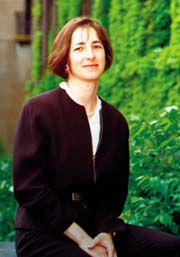

System for guiding cell migration, adhesion has biomedical and regenerative medical applications
Scientists at the University of Toronto are taking regenerative medicine to a new dimension with a process for guiding nerve cells that could someday help reconnect severed nerve endings.
Molly Shoichet, a professor of chemical engineering and applied chemistry at the Institute for Biomaterials and Biomedical Engineering (IBBME), has devised a new method that helps guide cell migration and adhesion. “We’re very interested in using this system for biomedical applications and regenerative medicine, specifically for guiding nerve cells,” says Shoichet, who holds the Canada Research Chair in Tissue Engineering.
In the study, Shoichet and doctoral student Ying Luo combined a gel-like substance called agarose with compounds having “photolabile” properties that change chemically when exposed to light. When they directed laser light at the gel, its chemical composition changed, creating a “channel” through the gel. Although not a physical channel, the interaction created a “growth-friendly” chemical pathway through the agarose.
Luo then placed neural cells at the opening of the channels. She and Shoichet found that the cells migrate into and through the channels, filling the pathways rather than clinging to the periphery. “Our findings have important implications for guiding where cells go and providing a greater surface area for the neural stimuli to be transmitted,” she says. Shoichet adds that it is not yet known whether this will lead to stronger signals passing through regenerated nerves.
“This is the first example of doing 3-D patterning with this type of gel material and is applicable to transparent materials,” says Shoichet. While previous techniques have created three-dimensional gel structures, they involved a time-consuming layering process.
The study, which appears in the March 21 advanced online publication of the journal Nature Materials, was funded by the Natural Sciences and Engineering Research Council of Canada, an Ontario Graduate Scholarship and a Connaught Fellowship.












